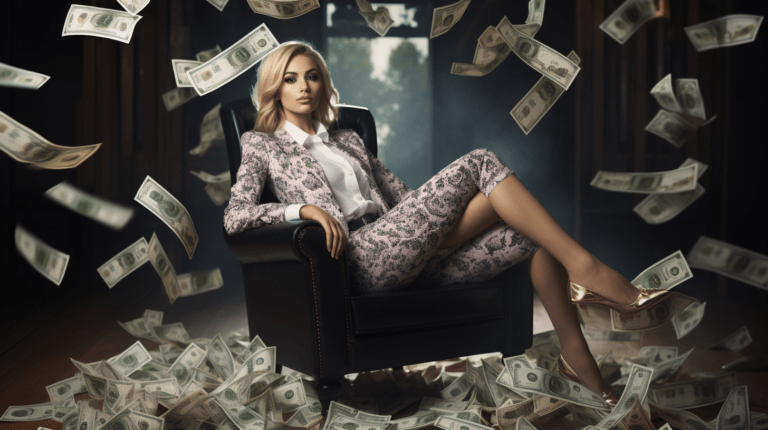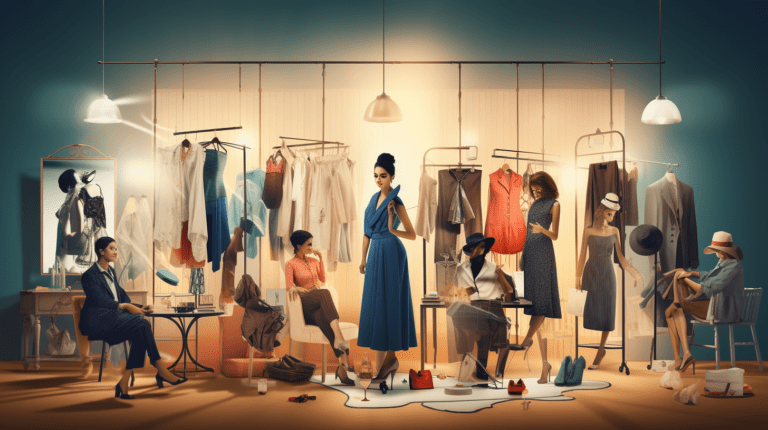Fashion Stylist Description – You’ve probably stumbled upon that perfect ensemble in a magazine, or witnessed a celebrity on the red carpet looking effortlessly chic and thought, ‘How do they pull it off?’
The secret ingredient is often an unsung hero of the fashion world – a fashion stylist. You see, they are the magicians who transform ordinary into extraordinary with their impeccable sense of style and attention to detail.
But what exactly does this glamorous job entail? What skills are required? How can you embark on such a career path?
Whether you’re simply intrigued by the behind-the-scenes action, or considering venturing into this exciting profession, this article will provide an in-depth look at the role of a fashion stylist.
So buckle up as we unravel the threads of one of the most influential roles in the fashion industry.
Key Takeaways – Fashion Stylist Description
- Fashion stylists transform ordinary outfits into extraordinary fashion statements.
- They balance creativity with practicality and have an eye for design and trend forecasting.
- Fashion stylists work with a range of clients, including celebrities, executives, and individuals, and require networking and negotiation skills.
- They play a significant role in shaping trends, promoting sustainability, and dictating personal style.
Understanding the Role of a Fashion Stylist – Fashion Stylist Description
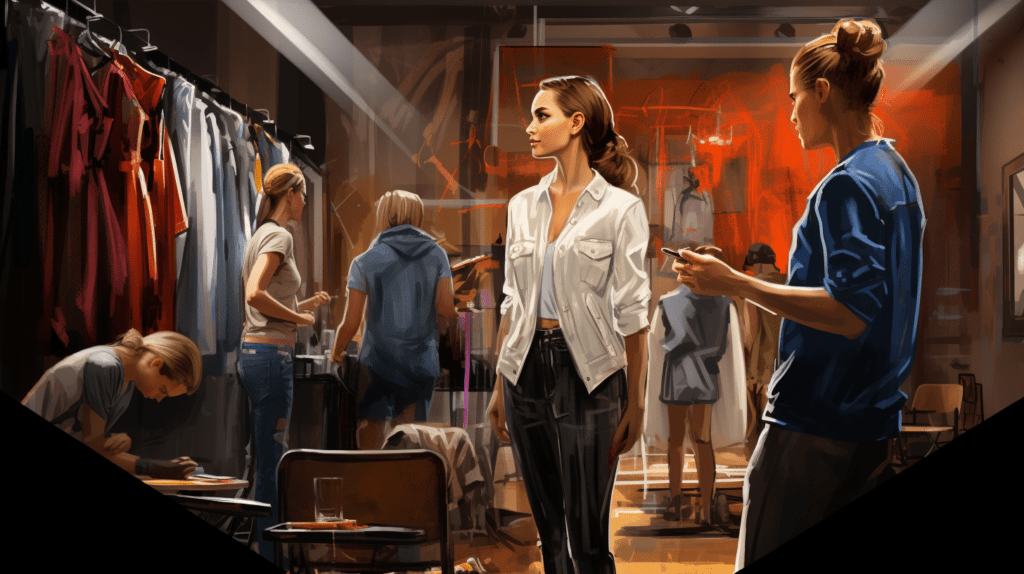
Imagine you’re the creative genius who transforms ordinary outfits into extraordinary fashion statements. That’s your role as a fashion stylist, and it’s not just about clothes – it’s about making people feel their most confident and radiant.
As a stylist, your canvas is the human form. You’re an artist with a mission to enhance personal branding through visual aesthetics.
The crux of your job revolves around understanding and predicting forthcoming trends while keeping in mind the unique tastes of each individual within your clientele range. You’ll engage in critical analysis of current styles to create looks that are both timely in their appeal yet timeless in their sophistication. This requires keen attention to detail, an intuitive sense for color palettes and textures, as well as an innate ability to balance creativity with practicality.
Your stylist’s clientele could vary from celebrities seeking statement-making red carpet ensembles, executives aiming for influential corporate attire, or individuals simply looking to revamp their everyday look. Each client represents a fresh challenge – an opportunity for you to wield the transformative power of style and translate it into tangible confidence.
Tirelessly working behind the scenes during photoshoots or runway shows, coordinating with designers, photographers, or makeup artists – every task contributes towards crafting an image that radiates power. So remember this: being a fashion stylist isn’t just about being up-to-date with trends; it’s about understanding how these trends can be manipulated to enhance personal branding.
Now let’s delve deeper into what makes someone truly excel in this dynamic world by exploring some essential skills required by successful fashion stylists.
Required Skills – Fashion Stylist Description
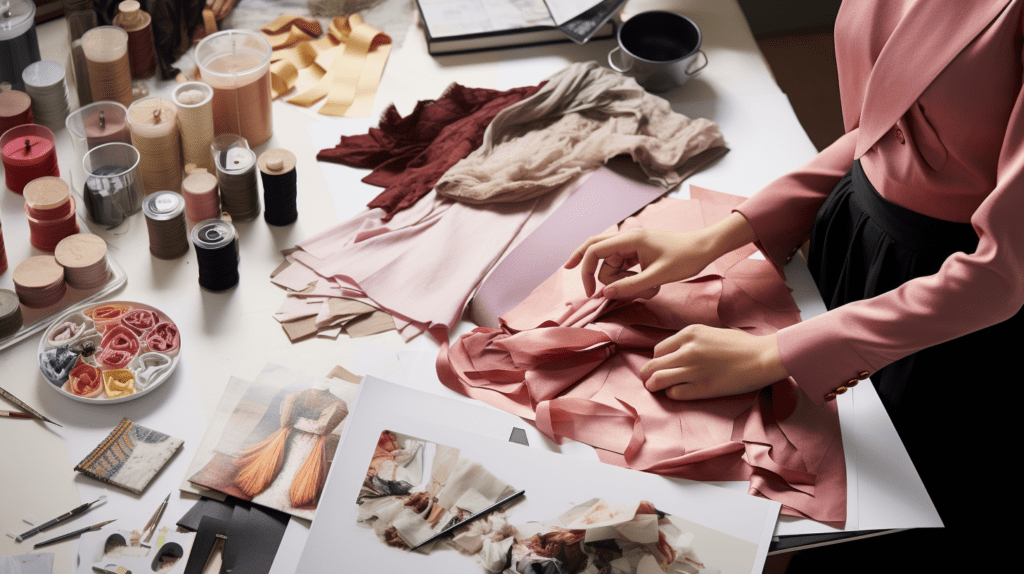
You’re stepping into a world where style is your language and the runway is your dictionary.
Your eye for design and trend forecasting skills will be crucial in keeping you ahead of the fashion curve, spotting what’s next before it becomes mainstream.
Moreover, networking and negotiation skills are key to securing the best deals for your clients and building strong relationships within the industry.
Eye for Design and Trend Forecasting
As a fashion stylist, it’s your innate ability to predict and incorporate emerging trends that sets you apart in the industry. Your eye for design inspiration and trend analysis is what keeps you ahead of the curve.
- Design Inspiration: You’re constantly exploring new looks, styles, and materials from various sources such as runway shows, celebrity fashion statements, or streetwear trends.
- Trend Analysis: You understand how to dissect current trends and foresee future ones by observing people’s behavior patterns and preferences.
- Adaptation: Once you’ve identified a trend, you know how to adapt it into wearable fashion that appeals to your clients’ individual style.
- Execution: Your ability to blend these elements seamlessly into your client’s wardrobe is what truly defines you as a successful stylist.
Having an eye for design isn’t enough though; networking and negotiation skills are also key components of your role.
Networking and Negotiation Skills
Building a robust network and mastering the art of negotiation can propel your success in this competitive industry. You need to develop Networking Etiquette that allows you to form strong professional relationships. Simultaneously, honing in on expert Negotiation Tactics is crucial to secure favorable terms for your clients.
| Skills | Description | Importance |
|---|---|---|
| Networking Etiquette | Building authentic relationships within the fashion industry. | It helps in gaining insider knowledge and opportunities. |
| Negotiation Tactics | Art of securing favorable deals without damaging relationships. | Crucial for client satisfaction and reputation building. |
| Communication Skills | Clear articulation of ideas and needs. | Ensures smooth transactions with designers or retailers. |
| Adaptability | Ability to be flexible under changing trends or demands. | Keeps you relevant in a dynamic industry. |
| Decision-Making | Choosing best options for clients based on their unique needs. | Directly impacts client’s image or brand. |
As we delve deeper into the world of fashion stylists, we’ll explore their significant influence over the fashion industry landscape.
The Importance of Fashion Stylists in the Fashion Industry – Fashion Stylist Description

Isn’t it fascinating how fashion stylists hold such a crucial role in the glamorous world of fashion? As creators of stunning visuals for brands and individuals, their influence permeates through every aspect of the industry. Fashion stylists aren’t just about making someone look good – they’re about telling a story, creating an identity, and pushing boundaries.
The stylist’s influence goes beyond what meets the eye:
- They shape trends: Have you ever wondered who decides which clothes end up on the runway or in photoshoots? The answer is often fashion stylists.
- They create narratives: Every outfit tells a story. Stylists understand this deeply and use their skills to craft engaging visual stories.
- They drive sales: A well-styled outfit can inspire consumers to buy, propelling profits for brands.
- They promote sustainability: Many stylists are now championing sustainable fashion, encouraging us to rethink our consumption habits.
- They dictate personal style: For celebrities and influencers alike, their public image is heavily influenced by their stylist’s vision.
With each dress fitted or suit tailored, they weave narratives that resonate with audiences worldwide. Their expertise has become essential amidst growing demands for authenticity and originality in fashion.
As trendsetters at heart, these professionals shape the industry’s future while respecting its past. Their work is integral to promoting fashion sustainability – proving that style doesn’t have to come at the environment’s expense – making them invaluable assets in today’s fast-paced world.
This exciting career path requires more than just an eye for aesthetics; it calls for a deep understanding of cultural contexts, market trends, client needs, and aspirations. The journey into becoming a successful stylist involves acquiring specialized education and comprehensive training which we’ll delve deeper into next.
Education and Training – Fashion Stylist Description

Diving headfirst into this artistic realm requires not just passion but also a rigorous blend of education and hands-on training. The fashion stylist profession, like other fields in the creative industry, thrives on a combination of theoretical knowledge and practical experience.
To start you off, let’s talk about the academic degrees needed. A Bachelor’s degree in Fashion Design or another related field is typically expected. However, having an advanced degree such as a Master’s can set you apart and open more doors for higher positions within the industry.
| Degree | Major | Benefits |
|---|---|---|
| Bachelor’s Degree | Fashion Design | Gives foundational understanding of fashion concepts |
| Master’s Degree | Luxury Brand Management | Provides deeper insights into luxury brand strategies |
| MBA | Business Administration | Enhances business acumen necessary for managing clients |
Styling internship opportunities are also crucial stepping stones towards your career as a fashion stylist. Internships provide invaluable hands-on experience that complements your theoretical knowledge from school. It gives you exposure to real-world challenges and solutions that occur in the styling industry every day.
This educational journey will not only equip you with vital skills but also help forge relationships with key people in the industry – designers, photographers, models – who might become instrumental in propelling your career forward.
The path to becoming a renowned fashion stylist demands both intellectual rigor and practical expertise; it is an intense process that molds novices into proficient professionals capable of wielding power over style trends.
So now we’ve covered education and training requirements; next up we’ll delve into various career pathways in the fashion styling industry to further discern where your passion may best manifest itself.
Career Pathways in the Fashion Styling Industry – Fashion Stylist Description
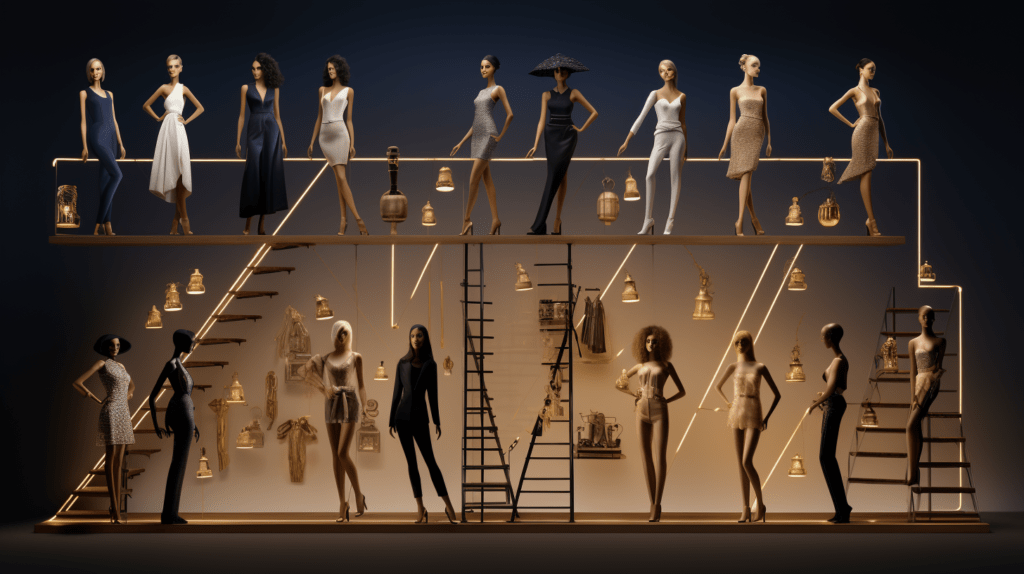
Navigating the landscape of the styling industry can feel like exploring a vast ocean, with each unique career pathway represented by a different current. Just as every ocean current has its own distinct path and destination, so does each career option within this dynamic field. Let’s say you’re an upcoming adventurer preparing to set sail; knowing your possible routes will guide your journey and help you reach your desired island of success.
Based on data from the U.S Bureau of Labor Statistics, opportunities in this umbrella are expected to grow 1% annually until 2024 – a testament to its expansive nature.
As an aspiring fashion stylist, consider these potential pathways:
- Editorial Styling: This involves creating looks for magazine editorials or online publications. Your creativity and understanding of trends are paramount here.
- Celebrity Styling: Imagine being responsible for red carpet appearances or even daily outfits for high-profile personalities! This requires impeccable taste and an ability to handle pressure.
- Catalogue Styling: Working closely with brands, catalog stylists ensure products look appealing for consumers in print or digital catalogs.
In all these careers, remember that stylist portfolio building is crucial. Displaying your work effectively can increase job prospects significantly and potentially boost your fashion stylist salary.
However, it’s not just about choosing a route; it’s about navigating through uncharted territories with confidence and conviction. It’s about harnessing power from within to create impactful statements that resonate long after the cameras stop flashing or the magazines have been put down.
Next up: facing challenges head-on without fear because just as there would be no rainbow without rain, there would be no successful fashion stylist without overcoming obstacles along their journey.
Challenges in the Fashion Styling Profession – Fashion Stylist Description
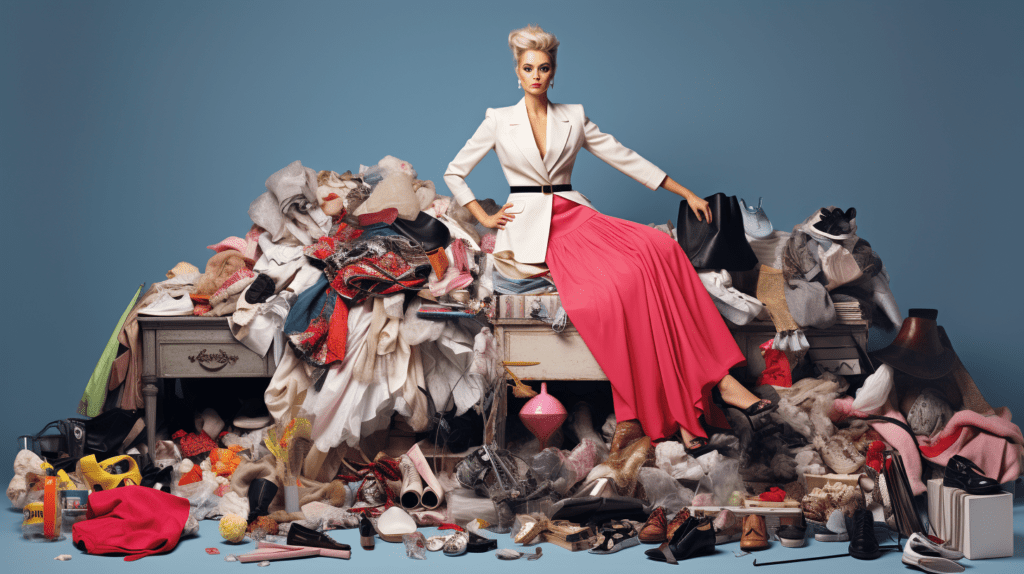
You’re probably wondering, ‘What are the challenges I might face in this glitzy profession?’ Well, it’s not all glamour and glitter. Being a fashion stylist comes with its fair share of trials.
First off, consider styling diversity. As a stylist, your clientele could range from high-powered executives to avant-garde artists. Each client has unique needs and personal styles that you must understand and cater to. It’s vital to be versatile and adaptable – able to seamlessly shift from one style genre to another, while maintaining an impeccable eye for aesthetics.
Additionally, you’ll encounter the sustainability aspects within the fashion industry. Increasingly aware clients will demand ethical clothing choices that don’t compromise their style or values. You’ll need an excellent grasp of sustainable fashion trends and brands which can be tricky when navigating a market saturated with fast-fashion products.
Time constraints also pose a challenge as you juggle between various projects simultaneously; sourcing outfits, attending fittings while ensuring every detail aligns perfectly for your client’s occasion or photo shoot is no easy feat.
Moreover, not all changes will be welcomed by clients who may resist stepping out of their comfort zones. Your persuasion skills coupled with deep knowledge about what suits them best will come into play here.
And let’s not forget the constant pressure to stay updated on ever-evolving fashion trends – it requires endless learning and adaptation but keeps things exciting!
Leaning into these obstacles builds resilience – key in this dynamic profession where change is the only constant.
Now that we’ve covered potential hurdles in becoming a top-notch stylist, let’s delve into how you can transform these challenges into opportunities for growth as we explore ways of breaking into this exhilarating world of fashion styling without mentioning ‘step’.
How to Become a Fashion Stylist – Fashion Stylist Description

Breaking into this fast-paced, ever-changing universe of style curation isn’t a walk in the park, but it’s definitely not climbing Mount Everest either. You’ve got to be ready to take control, and luckily for you, there are clear-cut steps you can follow to transform your passion for fashion into a successful career.
Firstly, immerse yourself in the industry. Understand the trends of yesterday, today, and predict those of tomorrow. Know your designers inside out; study their styles, inspirations, and target markets. But remember that knowledge alone won’t cut it – power comes from action.
This is where Stylist Portfolio Building comes into play. Create a stunning portfolio showcasing your distinct perspective on fashion – mix different looks, experiment with unconventional pairings, or flaunt minimalistic ensembles if that’s more your speed. Ensure every ensemble screams ‘you’ – authentic creativity is vital in standing out from other stylists.
Next up: Stylist Internships – an invaluable step towards gaining hands-on experience and networking within the industry. This isn’t just about fetching coffee; it’s an opportunity to learn from seasoned professionals who’ve navigated the ups and downs of this exciting world.
Do remember though that being a stylist requires more than an eye for aesthetics; you must also master project management skills such as client handling and budget planning. Constantly enhance these skills while staying updated on industry shifts to keep ahead of the game.
So gear up! The road may seem daunting now, but rest assured that each step will bring you closer to wielding power over fashion trends rather than following them blindly. Your journey starts here!
Frequently Asked Questions
What is the average salary of a fashion stylist?
As a fashion stylist, your earnings can vary greatly. On average, stylists earn around $50,000 annually. However, with more experience and stylist education under your belt, you could potentially command higher rates.
Freelance challenges may impact your income stability; it’s a competitive field with fluctuating demand. But remember, being up-to-date on fashion trends and having an eye for detail can give you the edge needed to excel in this industry and increase your earning potential substantially.
Are there any professional associations or organizations for fashion stylists?
Absolutely, there are oceans of associations for fashion stylists!
The Stylist Certification Process is your ticket to joining these professional leagues. Once you’re in, the world becomes your runway with countless Stylist Networking Opportunities.
You’ll rub shoulders with industry insiders and trendsetters, exchanging ideas that could redefine fashion norms. This isn’t just networking; it’s power-mongering at its fashionable best.
Stay ahead of trends and keep your finger on the pulse of style – all while enhancing your professional stature.
How has the role of a fashion stylist evolved over the years?
Over the years, a stylist’s influence has grown immeasurably. Once just behind-the-scenes coordinators, stylists are now powerful trendsetters shaping global fashion narratives.
Your role has expanded beyond outfit selection to brand development and personal image consultancy. Plus, stylist education is more robust than ever – offering specialized training in current trends and market dynamics.
You’re not just a wardrobe wizard anymore; you’re a style strategist with an eye for detail that can make or break an image.
What impact does a fashion stylist have on sustainability in the fashion industry?
Did you know that fashion stylists can influence up to 80% of a brand’s sustainability?
By opting for sustainable materials and practicing ethical sourcing, they play a vital role in reducing the industry’s carbon footprint.
They’re not just trendsetters; they’re game-changers, pushing for a kinder, greener fashion world.
Their choices dictate production practices and ultimately shape the future of fashion.
Powerful indeed, wouldn’t you agree?
The power to change is literally in their hands.
What are some common misconceptions about the profession of a fashion stylist?
You may think that being a stylist is all about glitz, glamour, and celebrities; these are common stylist stereotypes.
In reality, the career challenges include long hours, constant research on evolving fashion trends, and meticulous attention to detail. It’s not just about picking out clothes; it involves understanding client needs, industry demands, and sustainability practices.
The power in this profession lies in its ability to influence fashion narratives globally while managing an intricate web of responsibilities.
Conclusion
So, you’ve got the scoop on what it takes to be a fashion stylist. It’s not just about having an eye for style, but also understanding trends, developing skills, and meeting challenges head-on.
Imagine being the maestro of a symphony where clothes are your orchestra – that’s the life of a fashion stylist. And who knows? With dedication and passion, that could be you calling the shots in the next big fashion week! Read more on Fashion Stylist Description.

